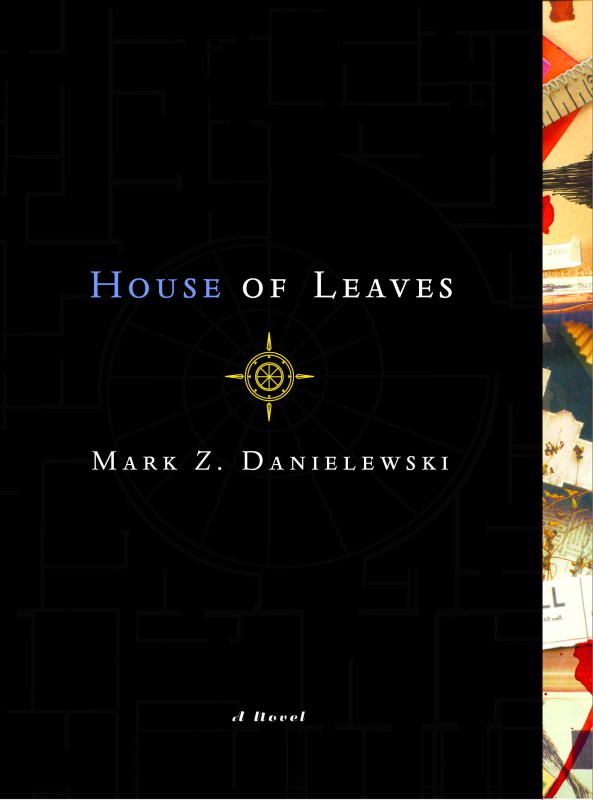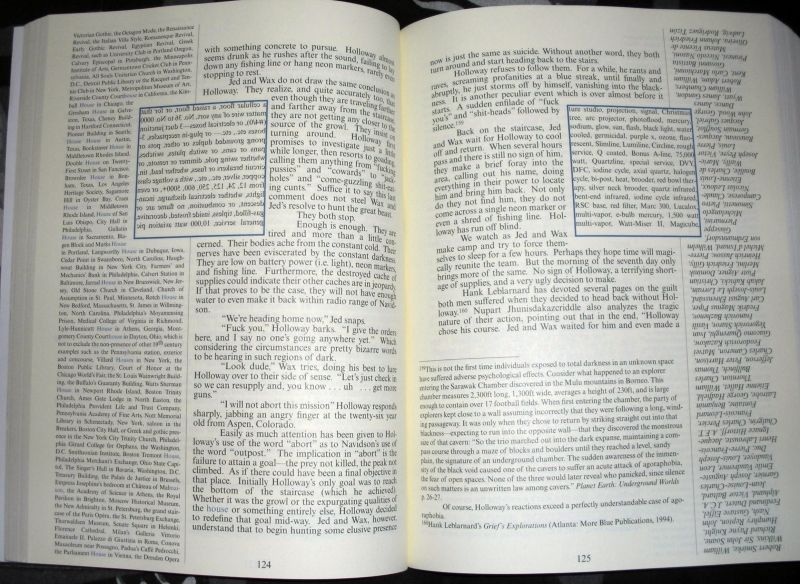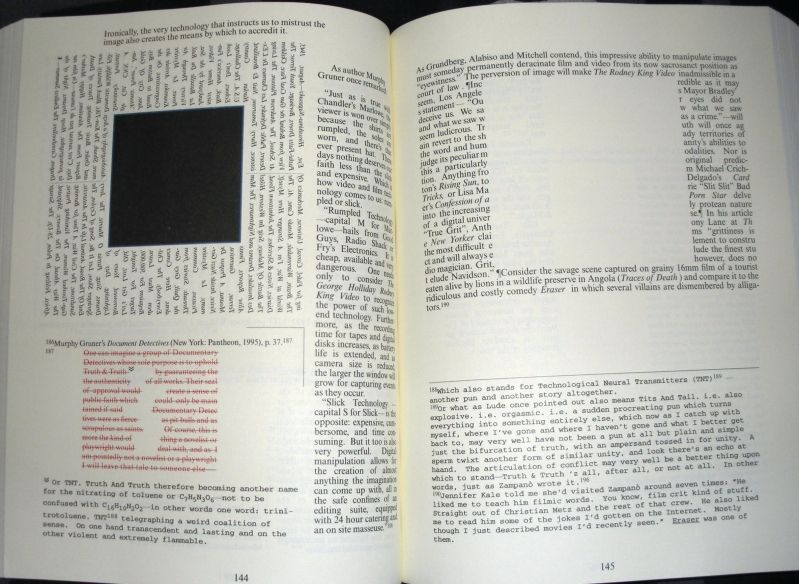One year ago: Horror of Dracula
House of Leaves aspires to reach into your brain with its sticky fingers and leave its messy fingerprints all over your mind. Simply put, Mark Danielewski's novel is a book-within-a-book-about-a-movie-that-doesn't-seem-to-exist... hell, that doesn't sound simple at all! And it really does get a bit complicated, but trust me, it's worth it. Even pages that look like this
or this
reward you for the minor amount of work you put into them. Some portions of the book are really just an academic critique, and those bits can drag, but even that works in the book's favor, as it adds to its authenticity. See, the book focuses on The Navidson Record, a film chronicling the story of the titular Navidson family as they realize that their new house is not what they expected. It begins when they realize the house is larger on the inside than on the outside, and things quickly escalate from there to levels of impossibility that boggle the mind. The elderly blind man Zampano has written a lengthy manuscript analyzing the film, and upon his death, it falls into the hands of Johnny Truant. JT becomes obsessed with the manuscript, reading further and further along, desperate to finish it, even as his life unravels around him. He provides footnotes that frequently ramble for pages at a time, and these footnotes often have footnotes of their own. JT's tirades can get tiresome, particularly when they distract you from some of the more interesting parts of the main narrative, but they do add more color and background if you read through them. However, if they are truly annoying you, many of the long one can be just skimmed, or even skipped altogether.
There is a good deal of what I feel compelled to call "wankery" present in the book. I gave you a glimpse of some of that in the images above; in addition, we have certain words or phrases printed in different colors-- the word "house" is always blue, for instance-- and codes worked into some pages, collages with hidden clues, and all manner of, well, wankery. I never really felt that the book was trying to be too clever, however; some of the purely cosmetic tricks, such as the blue "house," don't amount to much, but most of the techniques truly serve to enhance the story. There's a stretch of about twenty or so pages where only a few words are printed on each page, and it serves to propel the narrative at an even more blistering pace than would otherwise be achieved. I literally could not turn the pages fast enough, and it enhanced the mood during that scene a great deal.
As the book ends, there are a fair amount of unanswered questions, and it leaves the reader with a lot to mull over. Where these ruminations lead you can significantly alter your perception of what you've just read, and I came to my own conclusion not long after I put the book down.
Some of what follows may be considered mild spoilers, so hit "page down" a few times if you want to avoid them! I don't think anything I've typed will ruin the book or any of the suspense for you, but here's fair warning, just in case! Enjoy these kitty pictures in the meantime. (nothing says "Spoilers ahead" like kitties, eh?)
Ready? Zampano does not exist. Johnny Truant clearly suffers from serious mental illness, quite possibly the schizophrenia that plagued his mother. There are numerous occasions in JT's footnotes where he does and creates things completely independently of his conscious mind. I'm convinced that Zampano, and therefore the original HOL manuscript itself, is an unconscious creation of JT's. There are several things here and there that support this interpretation, but the main piece of evidence that sticks out to me is this: We are told again and again that Zampano is blind. His blindness is not something that happened recently. How does a blind man watch a film and describe so precisely every last visual element in the film, to the point of fauning over Navidson's exquisite composition of every shot in which he is in control of the camera? The vast majority of Zampano's contributions are firmly based in the realm of the visual, to which Zampano did not have access. A weak argument could be made that the film was intricately described for him, but such an argument seems so feeble that it carries no weight.
So, that brings us back to my original declaration: Zampano does not exist. This casts everything in an incredibly suspicious light, and indeed, the entire book can easily be dismissed as a work of pure fiction(the book is obviously fiction, of course, but we're talking about what's what within the world of the book itself, so bear with me here). Like all theories about this book, this does leave some loose ends. For instance, what about the hidden message to Zampano in one of the letters JT's mother writes to him from the mental institution? Could be dismissed as pure coincidence, of course. But maybe not, and it can still work with this theory. Many of the people and events he relates are surely fictional, and that could easily extend to the letters from his mother. Creating these letters himself, unbeknownst to himself, such coded messages were inserted by his subconscious mind to help perpetuate his false reality.
This theory also means that the Navidson record is almost certainly a creation of JT's mental illness as well. This covers all the bases, including why the film apparently does not actually exist, why none of the celebrities who supposedly commented on the film have ever heard of it when JT contacts them, and why a great many of the sources cited in the manuscript do not exist. The whole thing is the result of the inner workings of a complex and damaged mind.
END OF POTENTIAL SPOILER AREA
That's what I took from the book. I'm sure you have your own theories if you've read it, and they may well blow mine out of the water. However you interpret the material this books presents to you, it's a fun exercise. Any work that draws the reader in and involves them to such a degree is truly something special, and anyone with an interest in the horror genre-- though this book truly straddles several genres-- owes it to themselves to check it out. It took me a long time to get to it, but I'm damn glad I did.
My score:







No comments:
Post a Comment